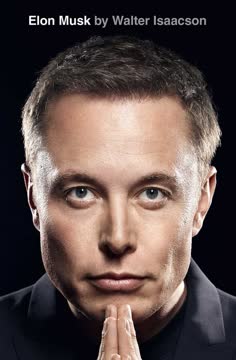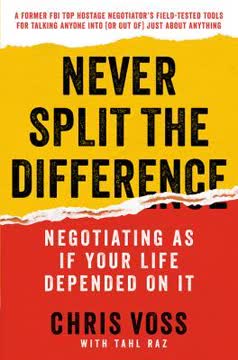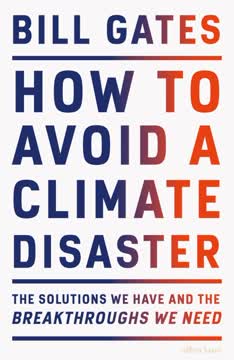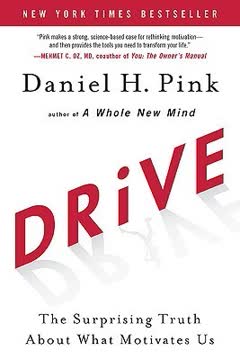Key Takeaways
1. Escape the gravitational pull of the past to free your company's future
To free your company's future from the pull of the past, to escape the gravitational field of your prior year's operating plan, and to complete the round-trip by returning with next year's operating plan, you need to apply a force that is greater than the inertial momentum of current operations.
Inertial resistance: Companies often find themselves trapped by the gravitational pull of their past success, unable to adapt to changing market conditions. This inertia is primarily driven by the prior year's operating plan, which institutionalizes current categories and resource allocations.
Breaking free: To achieve escape velocity, organizations must:
- Develop a compelling vision of the future that others want to support
- Set a strategy that positions the company as a leader in target markets
- Resource execution to accomplish high aspirations and generate superior economic returns
Overcoming obstacles: The process requires overcoming internal resistance, reallocating resources, and making asymmetrical bets on future opportunities. It demands leadership courage and a willingness to challenge the status quo.
2. Leverage the Hierarchy of Powers to drive strategic decision-making
The Hierarchy of Powers is a framework of frameworks. It sizes up all economic competitions in relation to five types of economic power, organized in descending order from most general to most specific.
Five levels of power: The Hierarchy of Powers provides a structured approach to evaluating and developing competitive advantage:
- Category Power
- Company Power
- Market Power
- Offer Power
- Execution Power
Strategic alignment: When these powers align and reinforce each other, they create synergy and drive superior performance. Misalignment or weakness in any area can undermine overall success.
Decision-making tool: The framework serves as a guide for executives to assess their current position, identify areas for improvement, and make strategic decisions that leverage their strengths across all five levels.
3. Harness Category Power to balance and optimize your portfolio
Category power is a function of the demand for a given class of products or services relative to all other classes.
Category life cycle: Categories evolve through five stages:
A. Emerging
B. Growth
C. Mature
D. Declining
E. End of Life
Portfolio management: Successful companies maintain a balanced portfolio across these stages, continuously entering new growth categories while divesting from declining ones.
Strategic imperatives:
- Invest heavily in Stage B (Growth) categories
- Optimize returns from Stage C (Mature) categories
- Divest early from Stage D (Declining) categories
- Avoid getting trapped in Stage E (End of Life) categories
4. Develop Company Power through asymmetrical bets on core capabilities
To make a difference of the magnitude we have been describing—to bring that difference into existence and instantiate it in your company—calls for an approach we term Lead first, manage second.
Crown jewels: Identify and invest in unique assets and capabilities that create sustainable competitive advantages. These may include technology, expertise, platform products, customer base, scale, brand, or business models.
Asymmetrical bets: Make bold, disproportionate investments in core capabilities to create unmatchable offers and escape the gravitational field of your competitive set.
Leadership imperatives:
- Secure buy-in from the top before launching initiatives
- Publish a clear vision and roadmap
- Commit fully to the chosen direction ("burn the boats")
- Fund core initiatives first and use "whatever it takes" as the resource standard
- Set major market tipping points as the metric of success
5. Create Market Power by dominating strategic market segments
Market power is simply company power specific to a particular market segment. Within the segment, you are the top dog, the big fish in your pond.
Target market initiatives (TMIs): Develop a playbook for creating market power through focused efforts on specific market segments. The goal is to achieve a dominant market share (50-80%) within the chosen segment.
Nine-point checklist for TMIs:
- Define target customer and compelling reason to buy
- Develop whole offer and identify partners/allies
- Create sales and pricing strategies
- Analyze competition and positioning
- Identify next target customer
Market transition opportunities: Focus on markets in transition, where existing infrastructure is being disrupted, to gain a foothold and establish leadership quickly.
6. Generate Offer Power with differentiated, neutralized, and productivity-driven innovations
Offer power takes up more of the total management conversation than any other element in the Hierarchy of Powers.
Three types of innovation:
- Differentiation innovation: Creates competitive separation through unmatchable offers
- Neutralization innovation: Catches up to competitors and maintains parity
- Productivity innovation: Extracts resources from legacy commitments to fund new initiatives
10X effect: Aim for innovations that deliver value an order of magnitude greater than current market standards to achieve true differentiation and escape velocity.
Resource allocation: Ruthlessly prioritize investments, focusing on core differentiation while managing context elements efficiently. Use the Core/Context model to guide decision-making.
7. Master Execution Power to drive organizational change and transitions
Execution is acting and reacting in real time to an ever-changing set of circumstances, all the while maintaining your strategic intent.
Four modes of execution:
- Invention: Led by visionary inventors in integrated teams
- Deployment: Led by pragmatic deployers in line-function organizations
- Optimization: Led by analytical optimizers in hierarchical structures
- Transition: Led by empathetic orchestrators in cross-functional teams
Arc of execution: Understand the evolution from invention to deployment to optimization, and manage transitions effectively between these phases.
Catalytic programs: Use executive-sponsored transition programs to drive organizational change and achieve tipping points in adoption of new initiatives.
8. Lead first, manage second: The key to achieving escape velocity
Leadership is about being in service to a higher cause; management is about ensuring that service is appropriately rewarded. Both are necessary. You just can't put the focus on rewards first.
Leadership courage: Making asymmetrical bets and driving organizational change requires bold leadership that prioritizes long-term vision over short-term rewards.
Management discipline: Once the direction is set, apply rigorous management practices to execute the strategy effectively and efficiently.
Balancing act: Successful companies maintain a dynamic tension between visionary leadership and pragmatic management, adapting their approach based on market conditions and organizational needs.
9. Innovate across three horizons to balance present and future growth
Horizon 1 investments are expected to contribute to material returns in the same fiscal year in which they are brought to market, thereby generating today's cash flow.
Three Horizons model:
- Horizon 1: Current core business
- Horizon 2: Emerging opportunities
- Horizon 3: Future growth options
Balancing investments: Allocate resources across all three horizons to ensure both short-term performance and long-term growth.
Horizon 2 challenge: Pay special attention to Horizon 2 initiatives, which often struggle to gain traction due to competition for resources with established Horizon 1 businesses.
10. Orchestrate transitions to catalyze transformative change
Catalytic programs are the primary and most powerful levers executives have for leading large organizations.
Transition programs: Develop specialized initiatives to drive organizational change from one execution mode to another (e.g., from invention to deployment).
Cross-functional teams: Assemble diverse teams led by skilled orchestrators to manage transitions effectively.
Executive sponsorship: Ensure top-level support and visibility for transition programs to signal their importance and drive engagement throughout the organization.
Tipping points: Focus on achieving critical mass in adoption and support to create self-sustaining momentum for change.
Last updated:
FAQ
What's "Escape Velocity: Free Your Company's Future from the Pull of the Past" about?
- Globalization and Change: The book discusses how globalization has shifted the competitive landscape, requiring companies to develop new skills to compete in emerging markets.
- Breaking Free from the Past: It emphasizes the need for companies to liberate themselves from outdated business models and assumptions that no longer serve them in a rapidly changing world.
- Strategic Frameworks: Geoffrey A. Moore introduces a series of frameworks to help companies achieve "escape velocity" by aligning vision, strategy, and execution.
- Focus on Innovation: The book highlights the importance of innovation in creating new growth opportunities and sustaining competitive advantage.
Why should I read "Escape Velocity: Free Your Company's Future from the Pull of the Past"?
- Strategic Insight: It provides valuable insights into how companies can adapt to the challenges of globalization and technological disruption.
- Practical Frameworks: The book offers practical frameworks and models that can be applied to real-world business scenarios to drive growth and innovation.
- Leadership Guidance: It emphasizes the role of leadership in making bold, asymmetrical bets to achieve competitive separation and long-term success.
- Case Studies: The book includes case studies from companies like Cisco, Adobe, and IBM, illustrating how they successfully navigated market transitions.
What are the key takeaways of "Escape Velocity: Free Your Company's Future from the Pull of the Past"?
- Hierarchy of Powers: Understanding the five types of economic power—category, company, market, offer, and execution—is crucial for strategic planning.
- Asymmetrical Bets: Companies must make bold, focused investments in their core capabilities to achieve competitive separation.
- Market Power: Targeting specific market segments in transition can lead to dominant market positions and sustainable growth.
- Execution Power: Successful execution requires transitioning from invention to deployment and optimization, with a focus on achieving tipping points.
How does Geoffrey A. Moore define "Category Power" in the book?
- Category Maturity Life Cycle: Moore describes the life cycle of categories from emerging to end-of-life, emphasizing the importance of participating in high-growth categories.
- Portfolio Management: Companies must assess their category portfolio to ensure a balance between current earnings and future growth opportunities.
- Growth/Materiality Matrix: This tool helps companies visualize their portfolio's contribution to growth and materiality, guiding strategic decisions.
- Three Horizons Model: It highlights the need to manage investments across different time horizons to sustain long-term growth.
What is the "Hierarchy of Powers" framework in "Escape Velocity"?
- Five Types of Power: The framework includes category, company, market, offer, and execution power, each contributing to a company's strategic positioning.
- Investor Perspective: It aligns with how investors evaluate companies, starting from category selection to execution performance.
- Alignment and Synergy: The framework emphasizes aligning these powers to create synergy and drive competitive advantage.
- Strategic Planning Tool: It serves as a comprehensive tool for strategic planning, helping companies focus on areas that will yield the highest returns.
What are "Asymmetrical Bets" according to Geoffrey A. Moore?
- Core Differentiation: Asymmetrical bets involve making focused investments in core capabilities that set a company apart from its competitors.
- Leadership Courage: These bets require leadership to commit to bold decisions that may go against conventional wisdom.
- Resource Allocation: Companies must skew resource allocation towards initiatives that have the potential to create unmatchable offers.
- Long-term Vision: Asymmetrical bets are often multiyear commitments that require patience and a clear vision of the desired future state.
How does "Escape Velocity" address "Market Power"?
- Target Market Initiatives: The book outlines a nine-point checklist for creating market power by targeting specific market segments.
- Tipping Points: Achieving a tipping point in a market segment can lead to dominant market positions and reduced competition.
- Compelling Offers: Companies must develop whole offers that address the specific needs of target segments to gain market power.
- Strategic Partnerships: Building alliances with partners and allies is crucial for delivering comprehensive solutions and gaining market traction.
What role does "Execution Power" play in achieving escape velocity?
- Arc of Execution: Execution power involves transitioning from invention to deployment and optimization, each requiring different leadership and organizational structures.
- Transition Programs: Catalytic programs are essential for driving transitions and achieving tipping points in execution.
- Four Modes of Execution: The book identifies invention, deployment, optimization, and transitioning as key modes of execution.
- Leadership and Orchestration: Successful execution requires orchestrators who can lead cross-functional teams through transitions.
What is the "Return on Innovation" model in the book?
- Three Types of Innovation: The model distinguishes between differentiation, neutralization, and productivity innovation, each serving different strategic purposes.
- Differentiation Innovation: Focuses on creating unmatchable offers that deliver 10X value compared to competitors.
- Neutralization Innovation: Ensures a company keeps pace with industry standards and remains competitive.
- Productivity Innovation: Aims to free resources from legacy commitments and optimize current operations.
What are the best quotes from "Escape Velocity" and what do they mean?
- "Globalization means a whole new ball game." This quote highlights the transformative impact of globalization on business strategy and the need for companies to adapt.
- "The pull of the past is most concretely embodied in your prior year’s operating plan." It emphasizes the challenge of breaking free from outdated business models and resource allocations.
- "Market transitions wait for no one." This quote underscores the urgency of adapting to market changes and seizing new opportunities.
- "Leadership is about being in service to a higher cause." It reflects the book's emphasis on visionary leadership and making bold, strategic decisions.
How does Geoffrey A. Moore suggest companies handle "Offer Power"?
- Breaking the Ties That Bind: Companies must free themselves from legacy commitments that hinder next-generation offers.
- Innovation in Productivity: Focus on optimizing current operations to free resources for future growth initiatives.
- Neutralization and Differentiation: Balance keeping pace with industry standards while investing in core differentiation for competitive advantage.
- Next-Generation Offers: Develop offers that deliver significant value and change the balance of power in the marketplace.
What is the significance of "Tipping Points" in "Escape Velocity"?
- Market Adoption: Tipping points are critical for gaining market adoption and achieving dominant positions in target segments.
- Catalytic Programs: These programs are designed to drive organizations to tipping points, facilitating transitions from invention to deployment.
- Strategic Focus: Achieving a tipping point requires a focused strategy and alignment of resources towards a common goal.
- Competitive Advantage: Once a tipping point is reached, it can lead to sustainable competitive advantage and reduced competition.
Review Summary
Escape Velocity receives mixed reviews, with an average rating of 3.9/5. Readers appreciate its insights on business strategy and innovation, particularly for large tech companies. Many find the frameworks and models valuable, though some criticize the dense writing style and narrow focus. Positive reviews highlight the book's actionable advice for overcoming organizational inertia, while critics note its limited applicability to smaller businesses. Overall, readers consider it a thought-provoking read with useful concepts, despite occasional repetition and complexity.
Similar Books










Download PDF
Download EPUB
.epub digital book format is ideal for reading ebooks on phones, tablets, and e-readers.








